CONTRACT LAW 10: Commercial Law Contract Law Analysis
VerifiedAdded on 2020/03/16
|10
|2608
|32
Homework Assignment
AI Summary
This assignment analyzes a contract law case involving Alan's attempt to sell a book. The analysis examines the formation of contracts with Bernard and Damien, focusing on the elements of offer, acceptance, consideration, capacity, intention, and clarity. It also addresses the issue of breach of contract due to Alan's failure to provide handwritten notes to Bernard and the correct book to Damien, as well as potential misrepresentation claims. The assignment further explores the lack of a contract with Charleen. Finally, it discusses the application of Alternative Dispute Resolution (ADR) methods, including arbitration, conciliation, and mediation, as potential solutions to resolve the disputes arising from the case. The analysis uses relevant case law to support its arguments and conclusions.

Commercial Law
Contract Law
(Student Details: )
01-Oct-17
Contract Law
(Student Details: )
01-Oct-17
Paraphrase This Document
Need a fresh take? Get an instant paraphrase of this document with our AI Paraphraser

CONTRACT LAW 2
Introduction
Contract can be defined as a promise undertaken in which one side of the party
promises to pay the consideration and in exchange of this the other party undertakes the task
which has been promised under the contract. For creating any contract, there is a need to
establish the existence of certain elements and these include an offer, its acceptance, value of
consideration, capacity to contract, clarity of terms and the intention of creating a contract. In
case the promise made under the contract is not fulfilled, a breach of contract occurs (Mulcahy,
2008). When such happens, the parties could opt for litigation, or solve the dispute through
Alternative Dispute Redressal (ADR) methods. In the upcoming segments, the discussion has
been carried on these very issues.
Answer (i)
Issue
In this case, the main issue is whether a contract had been rightly created in this case
and where it was, between which particular parties was it done.
Rule
Invitation to Treat and Offer
The very first requirement in forming the contract is an offer, in which one party has to
offer the other party some terms. It is important that a differentiation has been made between
an offer and an undertaken invitation to treat. Invitation to treat shows that the parties want to
initiate the negotiations, whereas the offer shows that the parties want to create lawful
relationship (Roach, 2016). The differentiation between the two can become important when it
comes to the published advertisements. Where the published advertisement covers a unilateral
offer, which can be accepted by performing on the terms of such published advertisement, it is
an offer as was seen in Carlill v Carbolic Smoke Ball Company [1893] 1 QB 256. But, in general
Introduction
Contract can be defined as a promise undertaken in which one side of the party
promises to pay the consideration and in exchange of this the other party undertakes the task
which has been promised under the contract. For creating any contract, there is a need to
establish the existence of certain elements and these include an offer, its acceptance, value of
consideration, capacity to contract, clarity of terms and the intention of creating a contract. In
case the promise made under the contract is not fulfilled, a breach of contract occurs (Mulcahy,
2008). When such happens, the parties could opt for litigation, or solve the dispute through
Alternative Dispute Redressal (ADR) methods. In the upcoming segments, the discussion has
been carried on these very issues.
Answer (i)
Issue
In this case, the main issue is whether a contract had been rightly created in this case
and where it was, between which particular parties was it done.
Rule
Invitation to Treat and Offer
The very first requirement in forming the contract is an offer, in which one party has to
offer the other party some terms. It is important that a differentiation has been made between
an offer and an undertaken invitation to treat. Invitation to treat shows that the parties want to
initiate the negotiations, whereas the offer shows that the parties want to create lawful
relationship (Roach, 2016). The differentiation between the two can become important when it
comes to the published advertisements. Where the published advertisement covers a unilateral
offer, which can be accepted by performing on the terms of such published advertisement, it is
an offer as was seen in Carlill v Carbolic Smoke Ball Company [1893] 1 QB 256. But, in general
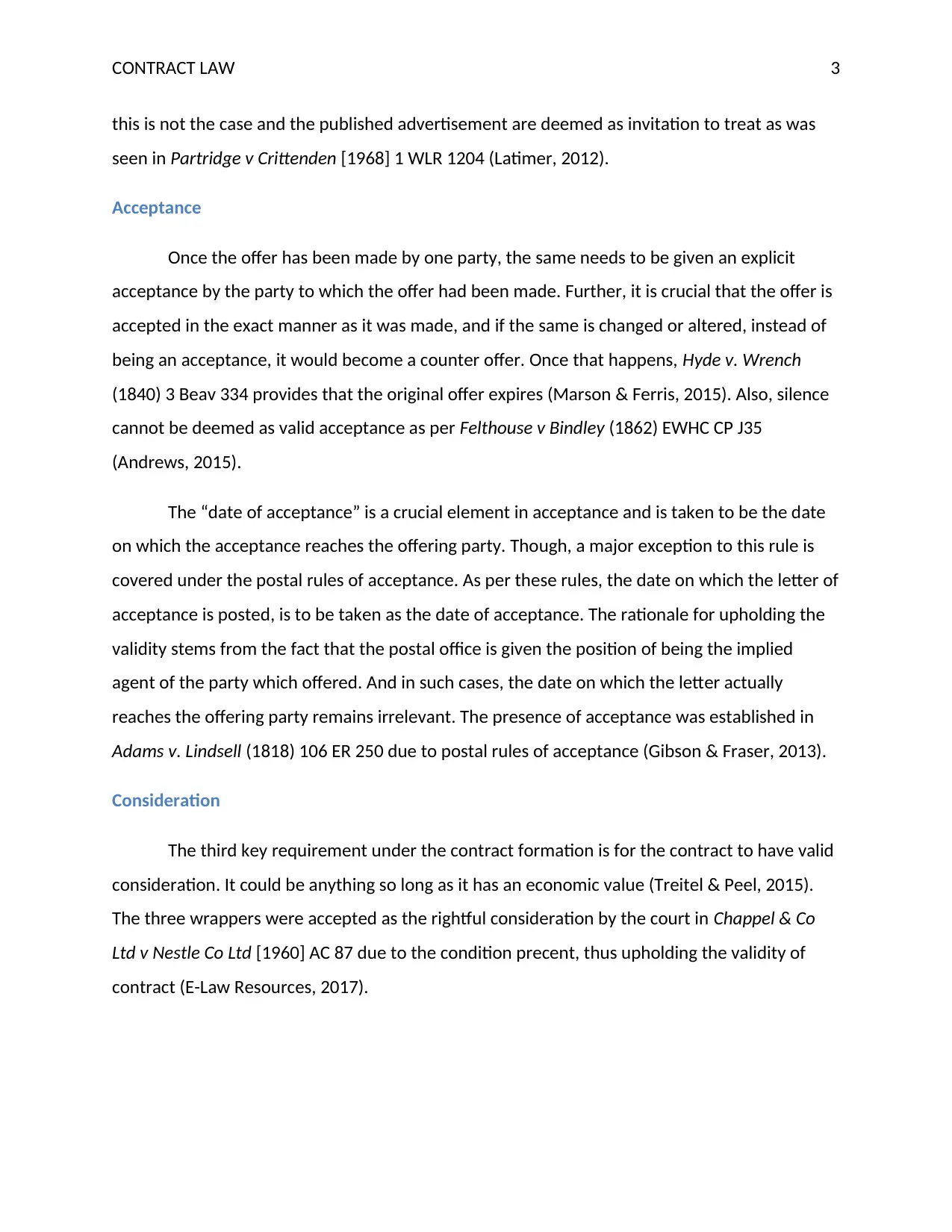
CONTRACT LAW 3
this is not the case and the published advertisement are deemed as invitation to treat as was
seen in Partridge v Crittenden [1968] 1 WLR 1204 (Latimer, 2012).
Acceptance
Once the offer has been made by one party, the same needs to be given an explicit
acceptance by the party to which the offer had been made. Further, it is crucial that the offer is
accepted in the exact manner as it was made, and if the same is changed or altered, instead of
being an acceptance, it would become a counter offer. Once that happens, Hyde v. Wrench
(1840) 3 Beav 334 provides that the original offer expires (Marson & Ferris, 2015). Also, silence
cannot be deemed as valid acceptance as per Felthouse v Bindley (1862) EWHC CP J35
(Andrews, 2015).
The “date of acceptance” is a crucial element in acceptance and is taken to be the date
on which the acceptance reaches the offering party. Though, a major exception to this rule is
covered under the postal rules of acceptance. As per these rules, the date on which the letter of
acceptance is posted, is to be taken as the date of acceptance. The rationale for upholding the
validity stems from the fact that the postal office is given the position of being the implied
agent of the party which offered. And in such cases, the date on which the letter actually
reaches the offering party remains irrelevant. The presence of acceptance was established in
Adams v. Lindsell (1818) 106 ER 250 due to postal rules of acceptance (Gibson & Fraser, 2013).
Consideration
The third key requirement under the contract formation is for the contract to have valid
consideration. It could be anything so long as it has an economic value (Treitel & Peel, 2015).
The three wrappers were accepted as the rightful consideration by the court in Chappel & Co
Ltd v Nestle Co Ltd [1960] AC 87 due to the condition precent, thus upholding the validity of
contract (E-Law Resources, 2017).
this is not the case and the published advertisement are deemed as invitation to treat as was
seen in Partridge v Crittenden [1968] 1 WLR 1204 (Latimer, 2012).
Acceptance
Once the offer has been made by one party, the same needs to be given an explicit
acceptance by the party to which the offer had been made. Further, it is crucial that the offer is
accepted in the exact manner as it was made, and if the same is changed or altered, instead of
being an acceptance, it would become a counter offer. Once that happens, Hyde v. Wrench
(1840) 3 Beav 334 provides that the original offer expires (Marson & Ferris, 2015). Also, silence
cannot be deemed as valid acceptance as per Felthouse v Bindley (1862) EWHC CP J35
(Andrews, 2015).
The “date of acceptance” is a crucial element in acceptance and is taken to be the date
on which the acceptance reaches the offering party. Though, a major exception to this rule is
covered under the postal rules of acceptance. As per these rules, the date on which the letter of
acceptance is posted, is to be taken as the date of acceptance. The rationale for upholding the
validity stems from the fact that the postal office is given the position of being the implied
agent of the party which offered. And in such cases, the date on which the letter actually
reaches the offering party remains irrelevant. The presence of acceptance was established in
Adams v. Lindsell (1818) 106 ER 250 due to postal rules of acceptance (Gibson & Fraser, 2013).
Consideration
The third key requirement under the contract formation is for the contract to have valid
consideration. It could be anything so long as it has an economic value (Treitel & Peel, 2015).
The three wrappers were accepted as the rightful consideration by the court in Chappel & Co
Ltd v Nestle Co Ltd [1960] AC 87 due to the condition precent, thus upholding the validity of
contract (E-Law Resources, 2017).
⊘ This is a preview!⊘
Do you want full access?
Subscribe today to unlock all pages.

Trusted by 1+ million students worldwide
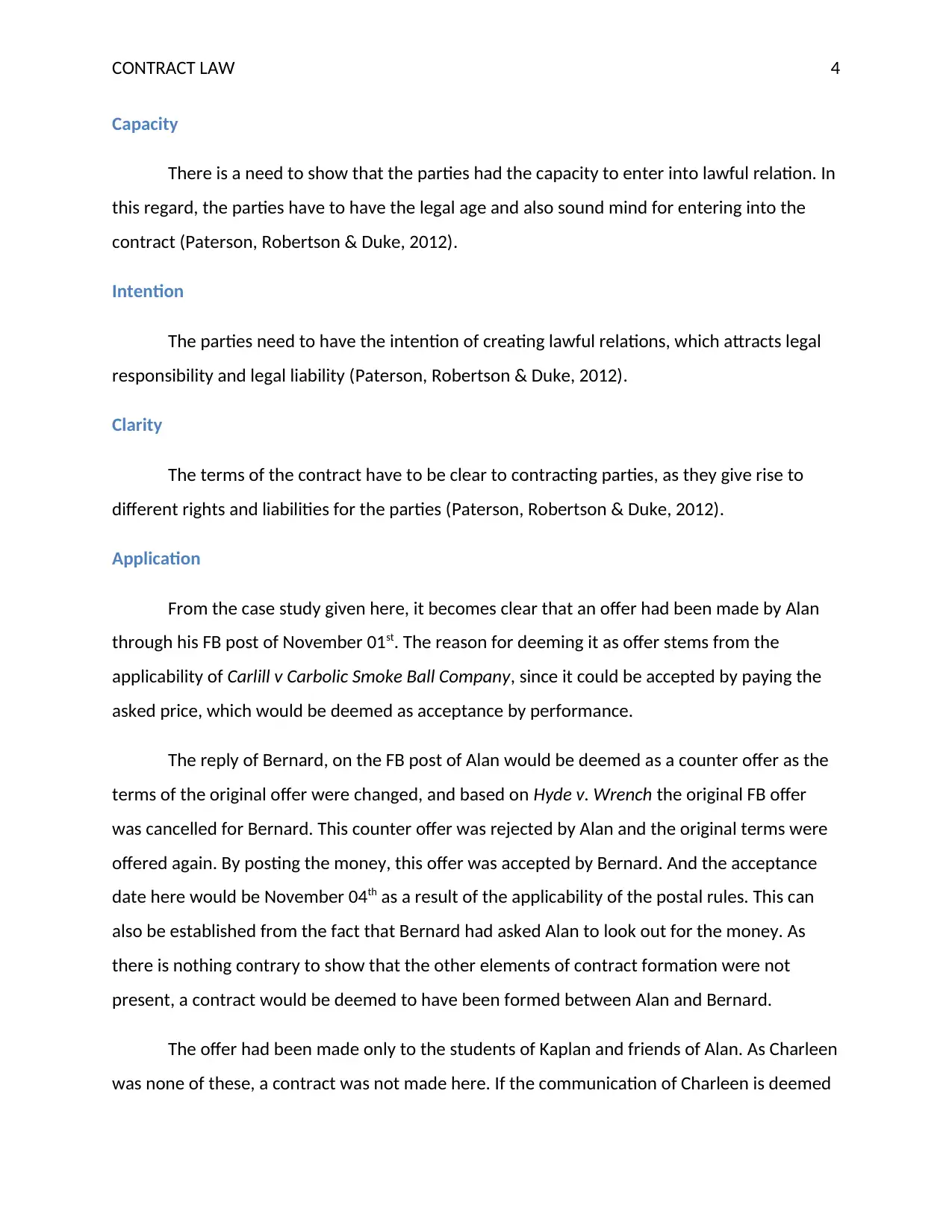
CONTRACT LAW 4
Capacity
There is a need to show that the parties had the capacity to enter into lawful relation. In
this regard, the parties have to have the legal age and also sound mind for entering into the
contract (Paterson, Robertson & Duke, 2012).
Intention
The parties need to have the intention of creating lawful relations, which attracts legal
responsibility and legal liability (Paterson, Robertson & Duke, 2012).
Clarity
The terms of the contract have to be clear to contracting parties, as they give rise to
different rights and liabilities for the parties (Paterson, Robertson & Duke, 2012).
Application
From the case study given here, it becomes clear that an offer had been made by Alan
through his FB post of November 01st. The reason for deeming it as offer stems from the
applicability of Carlill v Carbolic Smoke Ball Company, since it could be accepted by paying the
asked price, which would be deemed as acceptance by performance.
The reply of Bernard, on the FB post of Alan would be deemed as a counter offer as the
terms of the original offer were changed, and based on Hyde v. Wrench the original FB offer
was cancelled for Bernard. This counter offer was rejected by Alan and the original terms were
offered again. By posting the money, this offer was accepted by Bernard. And the acceptance
date here would be November 04th as a result of the applicability of the postal rules. This can
also be established from the fact that Bernard had asked Alan to look out for the money. As
there is nothing contrary to show that the other elements of contract formation were not
present, a contract would be deemed to have been formed between Alan and Bernard.
The offer had been made only to the students of Kaplan and friends of Alan. As Charleen
was none of these, a contract was not made here. If the communication of Charleen is deemed
Capacity
There is a need to show that the parties had the capacity to enter into lawful relation. In
this regard, the parties have to have the legal age and also sound mind for entering into the
contract (Paterson, Robertson & Duke, 2012).
Intention
The parties need to have the intention of creating lawful relations, which attracts legal
responsibility and legal liability (Paterson, Robertson & Duke, 2012).
Clarity
The terms of the contract have to be clear to contracting parties, as they give rise to
different rights and liabilities for the parties (Paterson, Robertson & Duke, 2012).
Application
From the case study given here, it becomes clear that an offer had been made by Alan
through his FB post of November 01st. The reason for deeming it as offer stems from the
applicability of Carlill v Carbolic Smoke Ball Company, since it could be accepted by paying the
asked price, which would be deemed as acceptance by performance.
The reply of Bernard, on the FB post of Alan would be deemed as a counter offer as the
terms of the original offer were changed, and based on Hyde v. Wrench the original FB offer
was cancelled for Bernard. This counter offer was rejected by Alan and the original terms were
offered again. By posting the money, this offer was accepted by Bernard. And the acceptance
date here would be November 04th as a result of the applicability of the postal rules. This can
also be established from the fact that Bernard had asked Alan to look out for the money. As
there is nothing contrary to show that the other elements of contract formation were not
present, a contract would be deemed to have been formed between Alan and Bernard.
The offer had been made only to the students of Kaplan and friends of Alan. As Charleen
was none of these, a contract was not made here. If the communication of Charleen is deemed
Paraphrase This Document
Need a fresh take? Get an instant paraphrase of this document with our AI Paraphraser
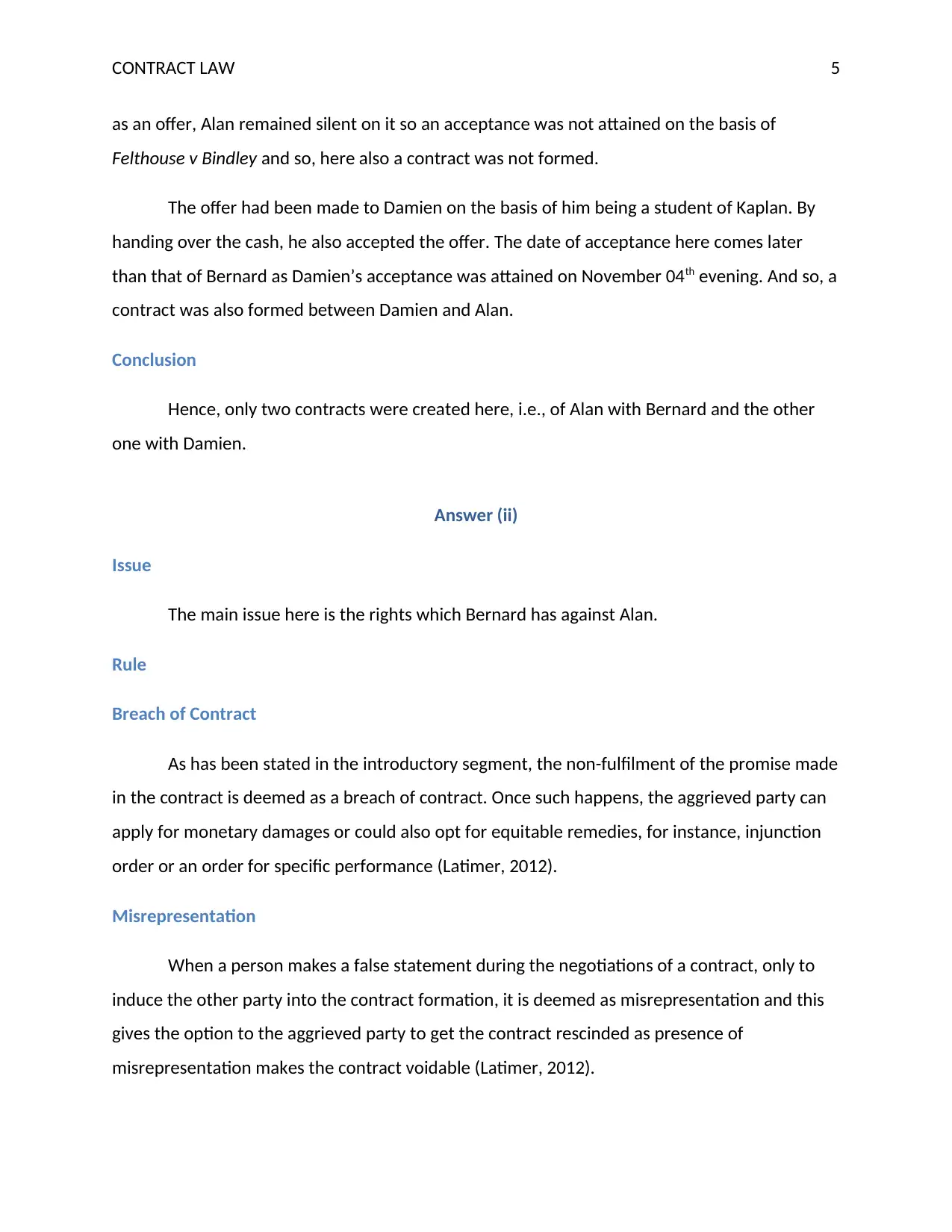
CONTRACT LAW 5
as an offer, Alan remained silent on it so an acceptance was not attained on the basis of
Felthouse v Bindley and so, here also a contract was not formed.
The offer had been made to Damien on the basis of him being a student of Kaplan. By
handing over the cash, he also accepted the offer. The date of acceptance here comes later
than that of Bernard as Damien’s acceptance was attained on November 04th evening. And so, a
contract was also formed between Damien and Alan.
Conclusion
Hence, only two contracts were created here, i.e., of Alan with Bernard and the other
one with Damien.
Answer (ii)
Issue
The main issue here is the rights which Bernard has against Alan.
Rule
Breach of Contract
As has been stated in the introductory segment, the non-fulfilment of the promise made
in the contract is deemed as a breach of contract. Once such happens, the aggrieved party can
apply for monetary damages or could also opt for equitable remedies, for instance, injunction
order or an order for specific performance (Latimer, 2012).
Misrepresentation
When a person makes a false statement during the negotiations of a contract, only to
induce the other party into the contract formation, it is deemed as misrepresentation and this
gives the option to the aggrieved party to get the contract rescinded as presence of
misrepresentation makes the contract voidable (Latimer, 2012).
as an offer, Alan remained silent on it so an acceptance was not attained on the basis of
Felthouse v Bindley and so, here also a contract was not formed.
The offer had been made to Damien on the basis of him being a student of Kaplan. By
handing over the cash, he also accepted the offer. The date of acceptance here comes later
than that of Bernard as Damien’s acceptance was attained on November 04th evening. And so, a
contract was also formed between Damien and Alan.
Conclusion
Hence, only two contracts were created here, i.e., of Alan with Bernard and the other
one with Damien.
Answer (ii)
Issue
The main issue here is the rights which Bernard has against Alan.
Rule
Breach of Contract
As has been stated in the introductory segment, the non-fulfilment of the promise made
in the contract is deemed as a breach of contract. Once such happens, the aggrieved party can
apply for monetary damages or could also opt for equitable remedies, for instance, injunction
order or an order for specific performance (Latimer, 2012).
Misrepresentation
When a person makes a false statement during the negotiations of a contract, only to
induce the other party into the contract formation, it is deemed as misrepresentation and this
gives the option to the aggrieved party to get the contract rescinded as presence of
misrepresentation makes the contract voidable (Latimer, 2012).

CONTRACT LAW 6
Application
In this case, Alan had to sell the book to Bernard which he attained from university,
along with the handwritten notes. Though, this promise was not fulfilled as the handwritten
notes were not given to him. This would allow Bernard to initiate a case of breach of contract
and seek compensation from Alan and also, apply for specific performance or injunction
whereby Alan could be asked to give the handwritten notes to Bernard or be stopped from
giving the same to Damien. A case of misrepresentation can also be made as the false
statement was made by Alan to induce Bernard into the contract.
Conclusion
Hence, Bernard can make a case against Alan for both the breach of contract and
undertaken misrepresentation.
Answer (iii)
Issue
The main issue here is the rights which Charleen has against Alan.
Rule
Breach of Contract
Application
Since no contract was formed between Charleen and Alan, no claim of breach of
contract cane made. However, Charleen can ask Alan to repay the money paid by her.
Conclusion
Hence, Charleen cannot make a case against Alan for both the breach of contract.
Application
In this case, Alan had to sell the book to Bernard which he attained from university,
along with the handwritten notes. Though, this promise was not fulfilled as the handwritten
notes were not given to him. This would allow Bernard to initiate a case of breach of contract
and seek compensation from Alan and also, apply for specific performance or injunction
whereby Alan could be asked to give the handwritten notes to Bernard or be stopped from
giving the same to Damien. A case of misrepresentation can also be made as the false
statement was made by Alan to induce Bernard into the contract.
Conclusion
Hence, Bernard can make a case against Alan for both the breach of contract and
undertaken misrepresentation.
Answer (iii)
Issue
The main issue here is the rights which Charleen has against Alan.
Rule
Breach of Contract
Application
Since no contract was formed between Charleen and Alan, no claim of breach of
contract cane made. However, Charleen can ask Alan to repay the money paid by her.
Conclusion
Hence, Charleen cannot make a case against Alan for both the breach of contract.
⊘ This is a preview!⊘
Do you want full access?
Subscribe today to unlock all pages.

Trusted by 1+ million students worldwide
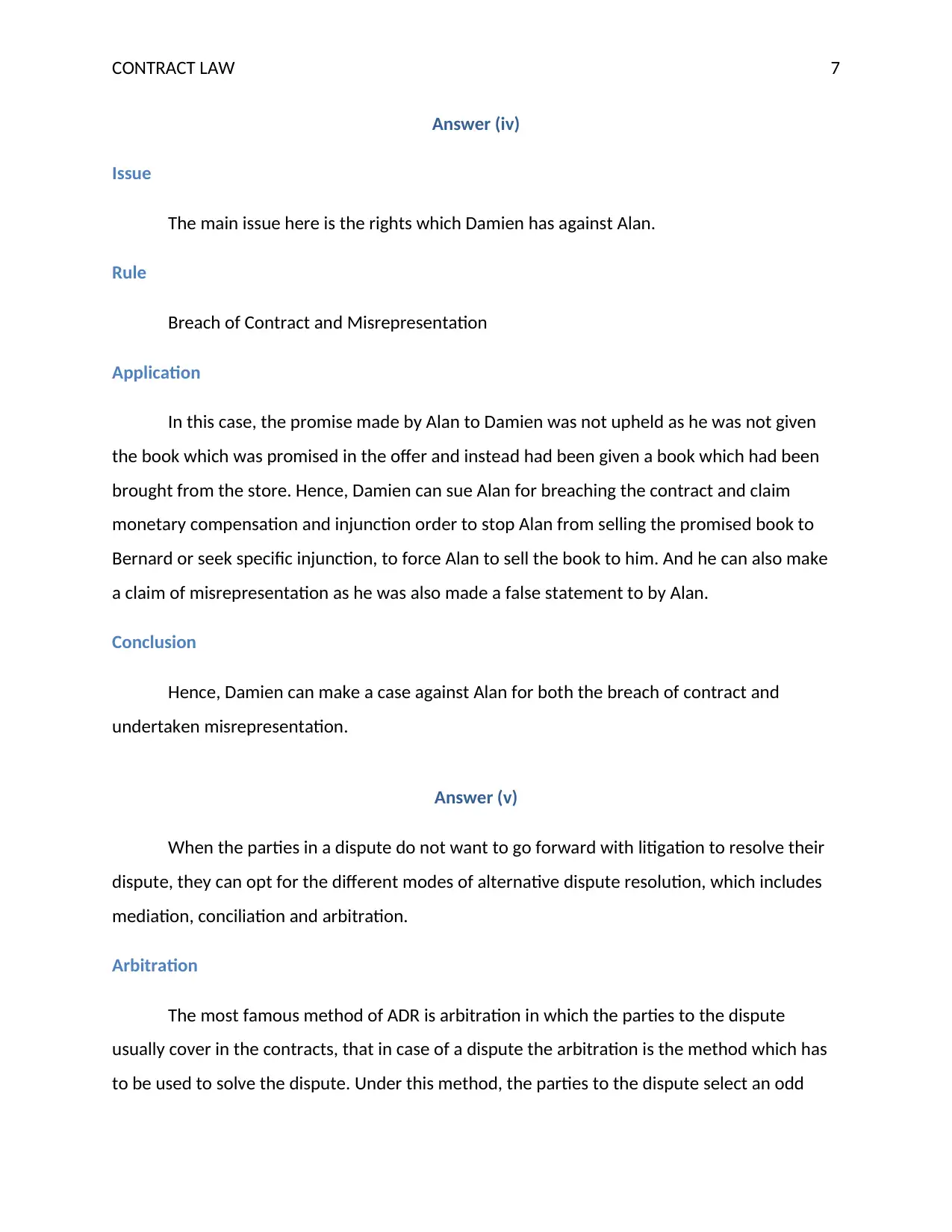
CONTRACT LAW 7
Answer (iv)
Issue
The main issue here is the rights which Damien has against Alan.
Rule
Breach of Contract and Misrepresentation
Application
In this case, the promise made by Alan to Damien was not upheld as he was not given
the book which was promised in the offer and instead had been given a book which had been
brought from the store. Hence, Damien can sue Alan for breaching the contract and claim
monetary compensation and injunction order to stop Alan from selling the promised book to
Bernard or seek specific injunction, to force Alan to sell the book to him. And he can also make
a claim of misrepresentation as he was also made a false statement to by Alan.
Conclusion
Hence, Damien can make a case against Alan for both the breach of contract and
undertaken misrepresentation.
Answer (v)
When the parties in a dispute do not want to go forward with litigation to resolve their
dispute, they can opt for the different modes of alternative dispute resolution, which includes
mediation, conciliation and arbitration.
Arbitration
The most famous method of ADR is arbitration in which the parties to the dispute
usually cover in the contracts, that in case of a dispute the arbitration is the method which has
to be used to solve the dispute. Under this method, the parties to the dispute select an odd
Answer (iv)
Issue
The main issue here is the rights which Damien has against Alan.
Rule
Breach of Contract and Misrepresentation
Application
In this case, the promise made by Alan to Damien was not upheld as he was not given
the book which was promised in the offer and instead had been given a book which had been
brought from the store. Hence, Damien can sue Alan for breaching the contract and claim
monetary compensation and injunction order to stop Alan from selling the promised book to
Bernard or seek specific injunction, to force Alan to sell the book to him. And he can also make
a claim of misrepresentation as he was also made a false statement to by Alan.
Conclusion
Hence, Damien can make a case against Alan for both the breach of contract and
undertaken misrepresentation.
Answer (v)
When the parties in a dispute do not want to go forward with litigation to resolve their
dispute, they can opt for the different modes of alternative dispute resolution, which includes
mediation, conciliation and arbitration.
Arbitration
The most famous method of ADR is arbitration in which the parties to the dispute
usually cover in the contracts, that in case of a dispute the arbitration is the method which has
to be used to solve the dispute. Under this method, the parties to the dispute select an odd
Paraphrase This Document
Need a fresh take? Get an instant paraphrase of this document with our AI Paraphraser
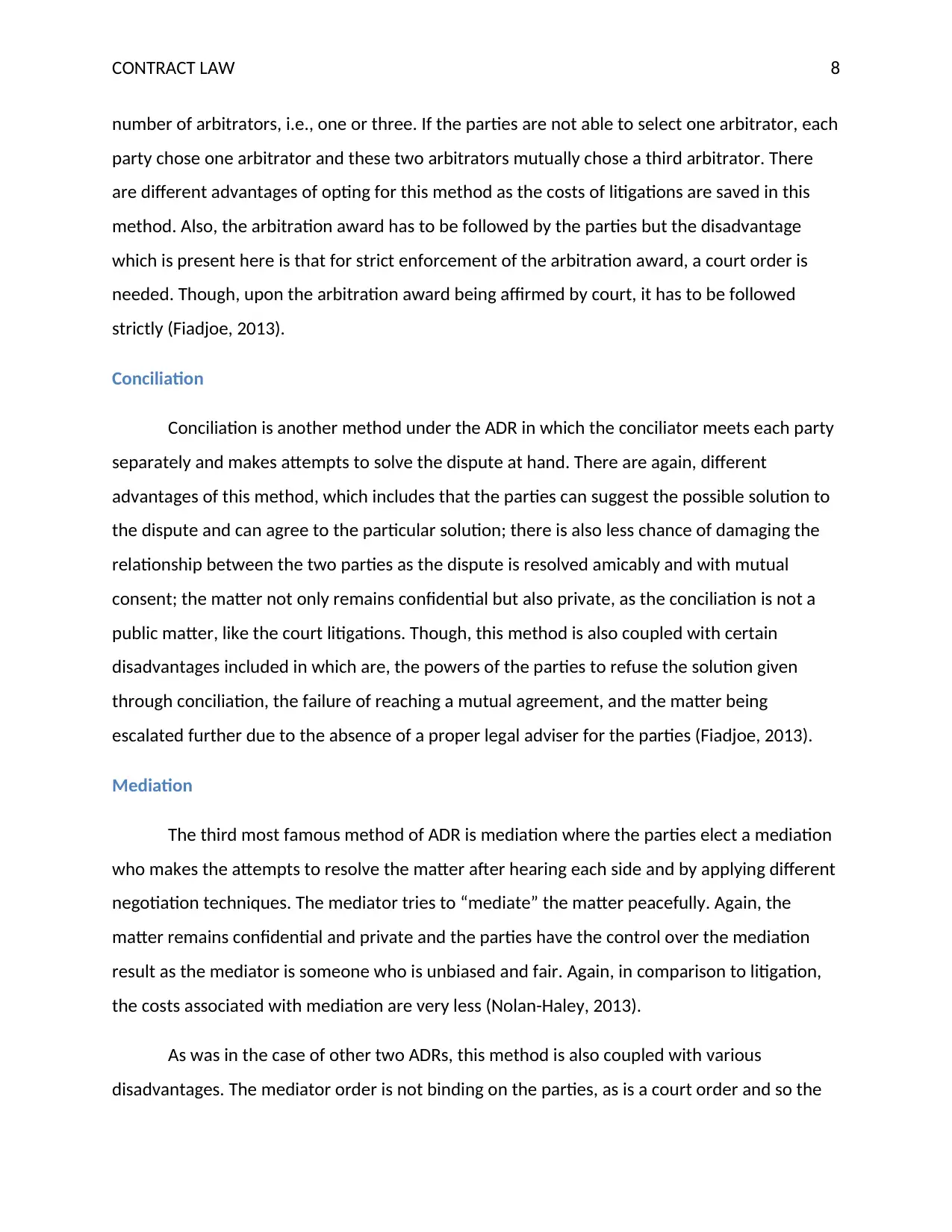
CONTRACT LAW 8
number of arbitrators, i.e., one or three. If the parties are not able to select one arbitrator, each
party chose one arbitrator and these two arbitrators mutually chose a third arbitrator. There
are different advantages of opting for this method as the costs of litigations are saved in this
method. Also, the arbitration award has to be followed by the parties but the disadvantage
which is present here is that for strict enforcement of the arbitration award, a court order is
needed. Though, upon the arbitration award being affirmed by court, it has to be followed
strictly (Fiadjoe, 2013).
Conciliation
Conciliation is another method under the ADR in which the conciliator meets each party
separately and makes attempts to solve the dispute at hand. There are again, different
advantages of this method, which includes that the parties can suggest the possible solution to
the dispute and can agree to the particular solution; there is also less chance of damaging the
relationship between the two parties as the dispute is resolved amicably and with mutual
consent; the matter not only remains confidential but also private, as the conciliation is not a
public matter, like the court litigations. Though, this method is also coupled with certain
disadvantages included in which are, the powers of the parties to refuse the solution given
through conciliation, the failure of reaching a mutual agreement, and the matter being
escalated further due to the absence of a proper legal adviser for the parties (Fiadjoe, 2013).
Mediation
The third most famous method of ADR is mediation where the parties elect a mediation
who makes the attempts to resolve the matter after hearing each side and by applying different
negotiation techniques. The mediator tries to “mediate” the matter peacefully. Again, the
matter remains confidential and private and the parties have the control over the mediation
result as the mediator is someone who is unbiased and fair. Again, in comparison to litigation,
the costs associated with mediation are very less (Nolan-Haley, 2013).
As was in the case of other two ADRs, this method is also coupled with various
disadvantages. The mediator order is not binding on the parties, as is a court order and so the
number of arbitrators, i.e., one or three. If the parties are not able to select one arbitrator, each
party chose one arbitrator and these two arbitrators mutually chose a third arbitrator. There
are different advantages of opting for this method as the costs of litigations are saved in this
method. Also, the arbitration award has to be followed by the parties but the disadvantage
which is present here is that for strict enforcement of the arbitration award, a court order is
needed. Though, upon the arbitration award being affirmed by court, it has to be followed
strictly (Fiadjoe, 2013).
Conciliation
Conciliation is another method under the ADR in which the conciliator meets each party
separately and makes attempts to solve the dispute at hand. There are again, different
advantages of this method, which includes that the parties can suggest the possible solution to
the dispute and can agree to the particular solution; there is also less chance of damaging the
relationship between the two parties as the dispute is resolved amicably and with mutual
consent; the matter not only remains confidential but also private, as the conciliation is not a
public matter, like the court litigations. Though, this method is also coupled with certain
disadvantages included in which are, the powers of the parties to refuse the solution given
through conciliation, the failure of reaching a mutual agreement, and the matter being
escalated further due to the absence of a proper legal adviser for the parties (Fiadjoe, 2013).
Mediation
The third most famous method of ADR is mediation where the parties elect a mediation
who makes the attempts to resolve the matter after hearing each side and by applying different
negotiation techniques. The mediator tries to “mediate” the matter peacefully. Again, the
matter remains confidential and private and the parties have the control over the mediation
result as the mediator is someone who is unbiased and fair. Again, in comparison to litigation,
the costs associated with mediation are very less (Nolan-Haley, 2013).
As was in the case of other two ADRs, this method is also coupled with various
disadvantages. The mediator order is not binding on the parties, as is a court order and so the

CONTRACT LAW 9
parties can chose to ignore the decision of the mediator. Hence, the time and money spent in
mediation could be wasted in attempts to save this by opting for mediation instead of litigation.
Also, in mediation, the parties cannot be forced to speak the truth, which can be done by the
court through court order, and unlike court summons, a party cannot be forced to go forward
with litigation. And the applicability of “precedents” is not done in mediation, so even when the
facts and circumstances of two disputes are same, the decision of one cannot be applied on the
other, as is done in cases of litigation (Nolan-Haley, 2013).
parties can chose to ignore the decision of the mediator. Hence, the time and money spent in
mediation could be wasted in attempts to save this by opting for mediation instead of litigation.
Also, in mediation, the parties cannot be forced to speak the truth, which can be done by the
court through court order, and unlike court summons, a party cannot be forced to go forward
with litigation. And the applicability of “precedents” is not done in mediation, so even when the
facts and circumstances of two disputes are same, the decision of one cannot be applied on the
other, as is done in cases of litigation (Nolan-Haley, 2013).
⊘ This is a preview!⊘
Do you want full access?
Subscribe today to unlock all pages.

Trusted by 1+ million students worldwide
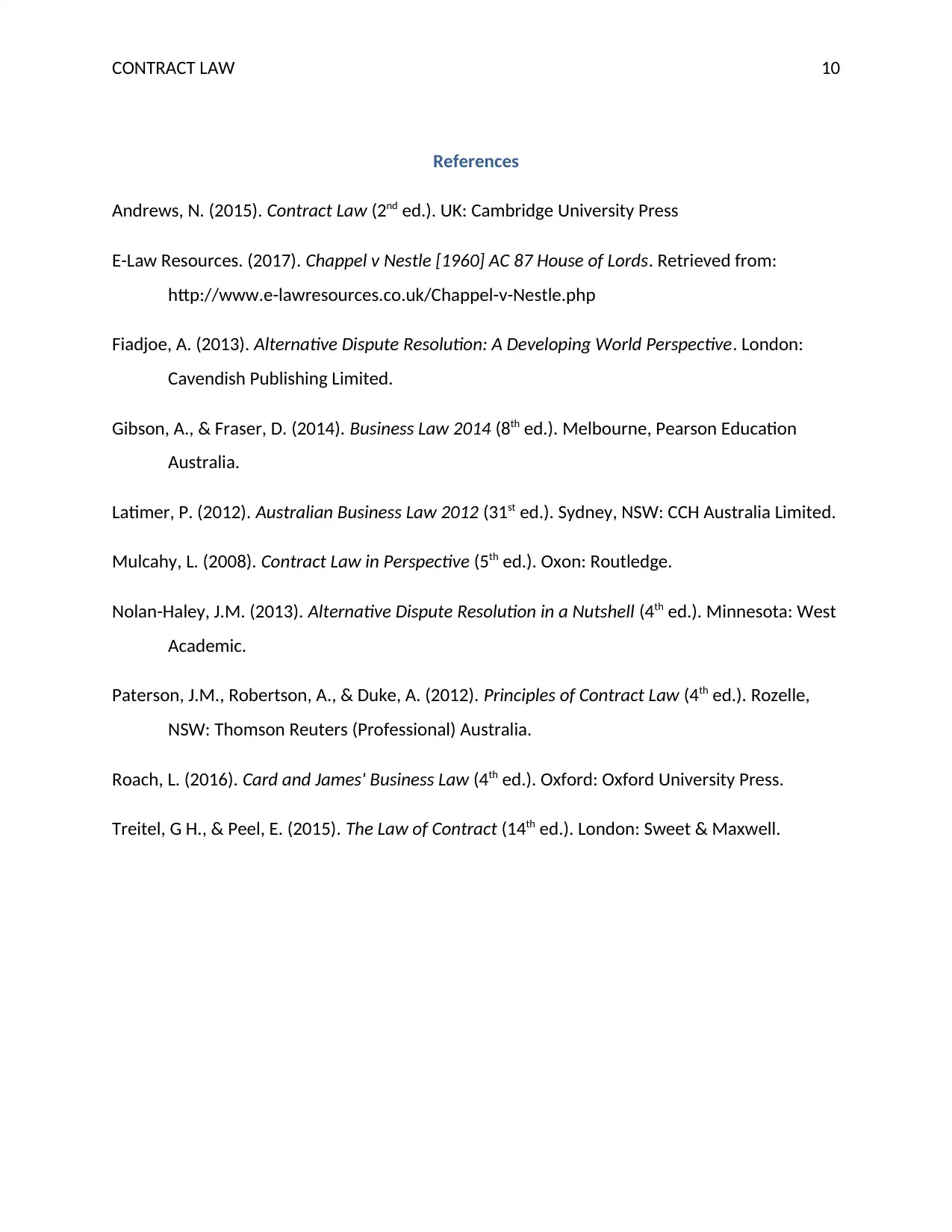
CONTRACT LAW 10
References
Andrews, N. (2015). Contract Law (2nd ed.). UK: Cambridge University Press
E-Law Resources. (2017). Chappel v Nestle [1960] AC 87 House of Lords. Retrieved from:
http://www.e-lawresources.co.uk/Chappel-v-Nestle.php
Fiadjoe, A. (2013). Alternative Dispute Resolution: A Developing World Perspective. London:
Cavendish Publishing Limited.
Gibson, A., & Fraser, D. (2014). Business Law 2014 (8th ed.). Melbourne, Pearson Education
Australia.
Latimer, P. (2012). Australian Business Law 2012 (31st ed.). Sydney, NSW: CCH Australia Limited.
Mulcahy, L. (2008). Contract Law in Perspective (5th ed.). Oxon: Routledge.
Nolan-Haley, J.M. (2013). Alternative Dispute Resolution in a Nutshell (4th ed.). Minnesota: West
Academic.
Paterson, J.M., Robertson, A., & Duke, A. (2012). Principles of Contract Law (4th ed.). Rozelle,
NSW: Thomson Reuters (Professional) Australia.
Roach, L. (2016). Card and James' Business Law (4th ed.). Oxford: Oxford University Press.
Treitel, G H., & Peel, E. (2015). The Law of Contract (14th ed.). London: Sweet & Maxwell.
References
Andrews, N. (2015). Contract Law (2nd ed.). UK: Cambridge University Press
E-Law Resources. (2017). Chappel v Nestle [1960] AC 87 House of Lords. Retrieved from:
http://www.e-lawresources.co.uk/Chappel-v-Nestle.php
Fiadjoe, A. (2013). Alternative Dispute Resolution: A Developing World Perspective. London:
Cavendish Publishing Limited.
Gibson, A., & Fraser, D. (2014). Business Law 2014 (8th ed.). Melbourne, Pearson Education
Australia.
Latimer, P. (2012). Australian Business Law 2012 (31st ed.). Sydney, NSW: CCH Australia Limited.
Mulcahy, L. (2008). Contract Law in Perspective (5th ed.). Oxon: Routledge.
Nolan-Haley, J.M. (2013). Alternative Dispute Resolution in a Nutshell (4th ed.). Minnesota: West
Academic.
Paterson, J.M., Robertson, A., & Duke, A. (2012). Principles of Contract Law (4th ed.). Rozelle,
NSW: Thomson Reuters (Professional) Australia.
Roach, L. (2016). Card and James' Business Law (4th ed.). Oxford: Oxford University Press.
Treitel, G H., & Peel, E. (2015). The Law of Contract (14th ed.). London: Sweet & Maxwell.
1 out of 10
Related Documents
Your All-in-One AI-Powered Toolkit for Academic Success.
+13062052269
info@desklib.com
Available 24*7 on WhatsApp / Email
![[object Object]](/_next/static/media/star-bottom.7253800d.svg)
Unlock your academic potential
Copyright © 2020–2025 A2Z Services. All Rights Reserved. Developed and managed by ZUCOL.





